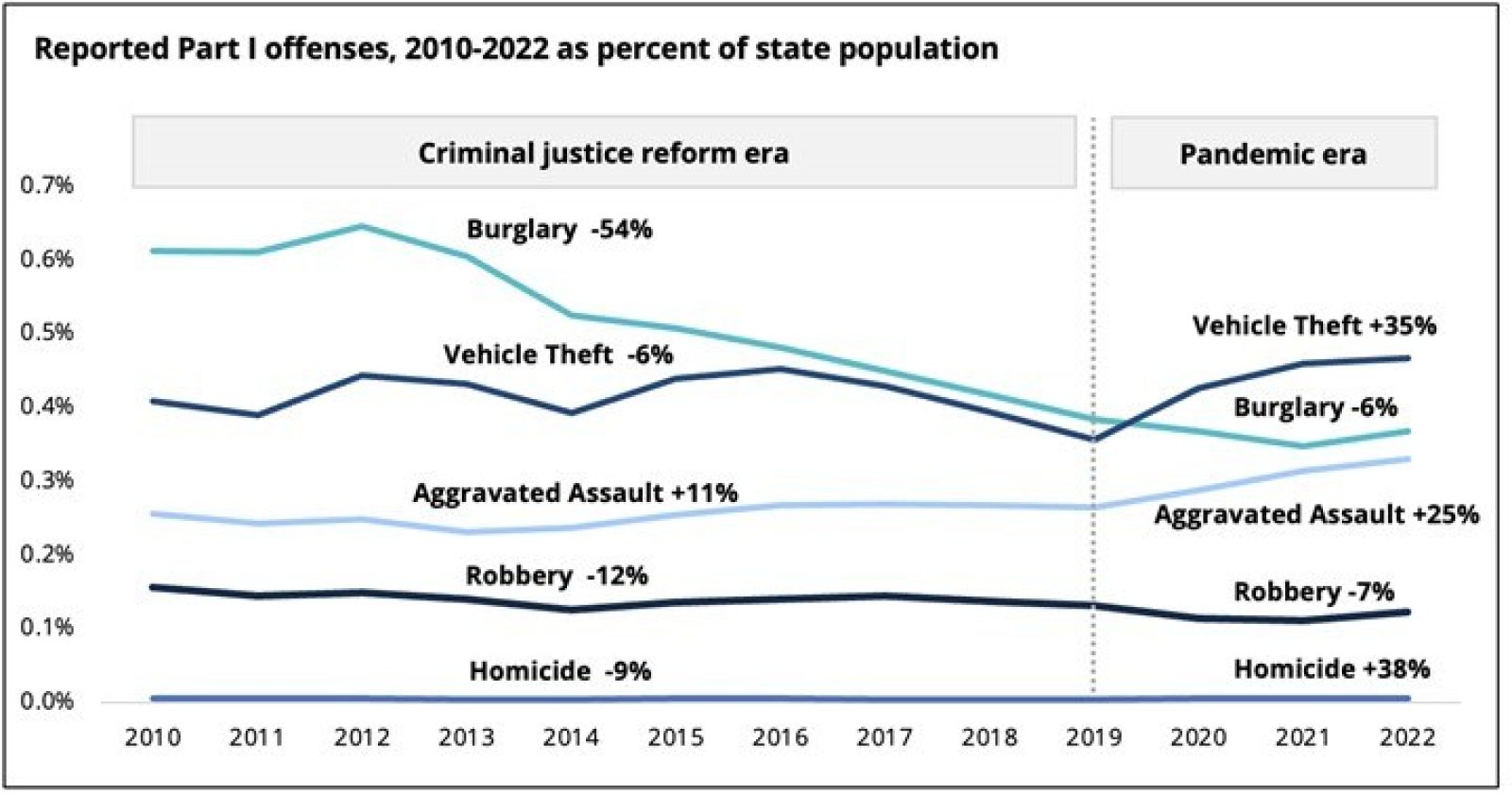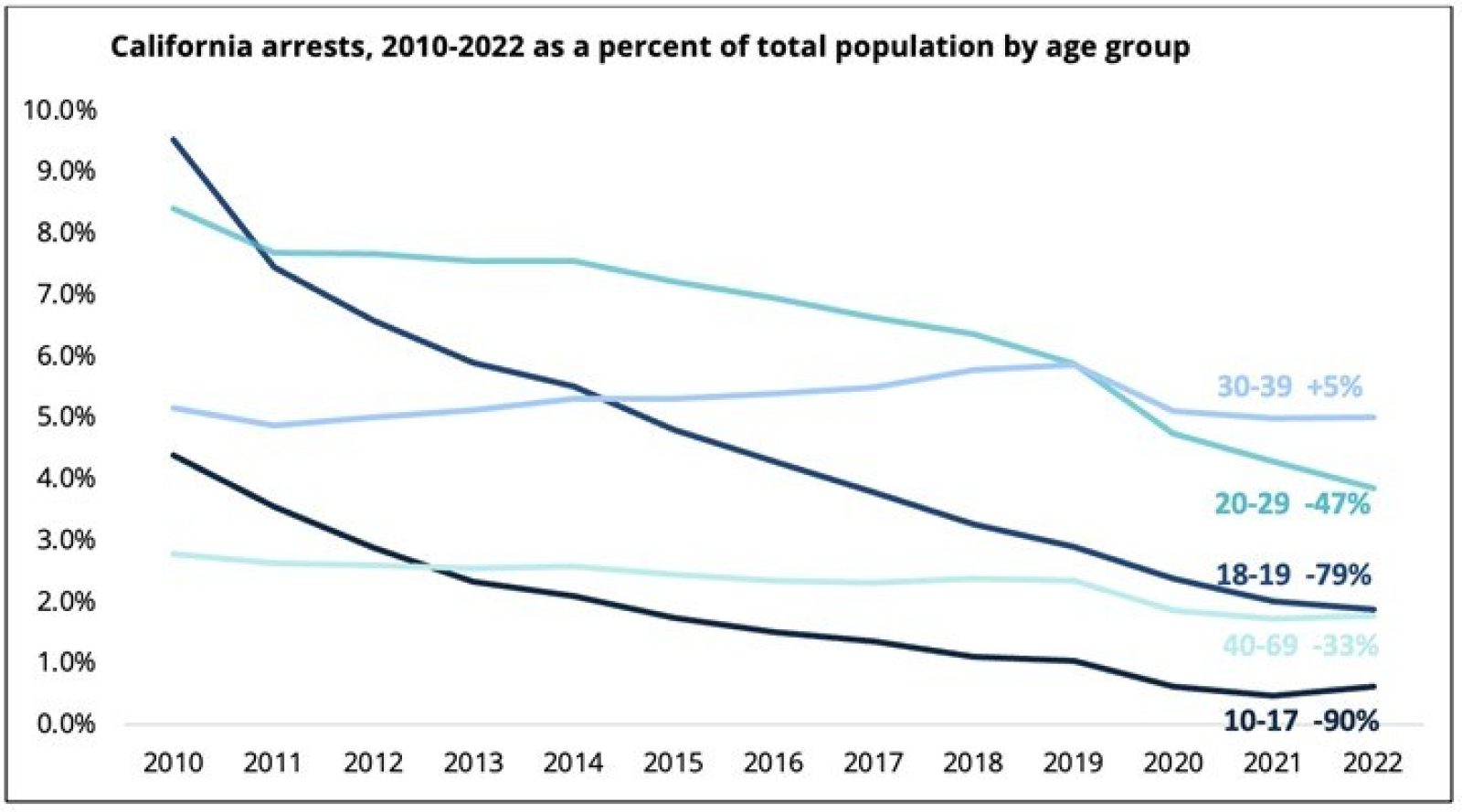California is emerging from one of its most turbulent historical periods. From 2010 through the early 2020s, California reclassified dozens of drug and property offenses from felonies to misdemeanors, increased felony theft thresholds, decriminalized then legalized marijuana, reduced adult prison populations from 163,000 to 96,000, reduced youth prison populations from 1,300 to zero (as of the DJJ’s closure on June 30, 2023), reduced local adult jail populations from 71,000 to 59,000 and juvenile detention populations from 8,500 to 2,500, all while weathering a major pandemic.
On the Two Eras’ Dramatically Different Crime Trends

Sources: DOF, 2023; DOJ, 2023. Note: Trendlines are generated by regression formulas incorporating all data points.
-While crime has fluctuated, arrests have shown consistent declines.
The effects of criminal justice reforms are being confused with those of the COVID-19 pandemic. California’s largest reforms took effect in 2011 (Realignment), 2014 (Prop 47), and 2016 (Prop 57) – long before the start of the pandemic. During the reform era, which we define as 2011 through 2019, rates of violent crime* increased slightly (up 2%) and property crime* fell substantially (down 24%), with four of the five major crime types* declining. During the pandemic period, 2020 through 2022, this trend reversed. Using 2019 as a baseline, rates of violent (up 16%) and property (up 13%) crimes both rose substantially, as did three of the five* major crimes.
While crime has fluctuated, arrests have shown consistent declines. Arrest rates fell by 47% between 2010 and 2022. This includes a 28% decline from 2010 – 2019 and a 9% decline from 2020 – 2022. During the full 2010 – 2022 period, arrest rates for youths under age 18 (down 90%), age 18 – 19 (down 79%), 20 – 29 (down 47%), and 40 – 69 (down 33%) all fell sharply, while age 30 – 39 rose (up 5%). These age patterns generally prevailed for violent, property, and drug offenses, including both felonies and misdemeanors. By 2022, teenagers’ crime rates had fallen to at or below middle-aged rates. Age 30 – 39 crime levels surpassed those of age 18 – 19 and 20 – 29 to become the highest of any age group.

Sources: DOF, 2023; DOJ, 2023. Note: Trendlines are generated by regression formulas incorporating all data points.
Despite massive declines in arrest rates, California made no progress in reducing racial disparities. Racial differences in 2022 remained largely the same as in 2010, though at much lower levels. The arrest rate for Black Californians remained around three times higher, and for violent crimes over five times higher, than for White Californians throughout the 2010 – 2022 period.
Women fared better than men in all areas of arrest except for violent crime, which fell by 18% for men but only 1% for women, while property crime arrest rates fell by 41% for men and 55% for women. Women also showed better trends in homicide and drug overdose deaths during the period, though both rose for both sexes during the pandemic.
Despite a fear-mongering campaign by opponents seeking to blame reforms for crime, California’s criminal justice reforms appear to have had beneficial effects on arrests and incarcerations while accompanying generally falling crime rates. However, the pandemic coincided with increased crime and mortality, including drug and gun deaths, suggesting state and local responses to emergency conditions need to improve.
It is crucial to keep perspective. Compared to 50 years ago (1972), California’s 2022 crime rates were 8% lower for violent crimes, including 35% lower for homicide, 49% lower for robbery, lower for rape, even with recently expanded definitions, and higher for assault likely because of increased policing of domestic violence. Further, California’s 2022 rate of motor vehicle theft is down 31%, other thefts are down 54%, and burglary is down 81% compared to 50 years ago. While crime rates have fluctuated over the last 15 years, they remain at historic lows. Californians are safer from crime today than in nearly all previous years of documentable history, and short-term ups and downs should not provoke panicked policy rollbacks.
* Rape and theft are excluded from reported crime due to changing definitions and arrest standards during the period.
-While crime rates have fluctuated over the last 15 years, they remain at historic lows. Californians are safer from crime today than in nearly all previous years of documentable history, and short-term ups and downs should not provoke panicked policy rollbacks.
Author’s Bio- Mike A. Males, Ph.D is a Senior Research Fellow at CJCJ. He has contributed research and co-authored numerous CJCJ publications, including on issues of drug policy, Three Strikes law, criminal justice realignment, and juvenile justice reform.Dr. Males has a Ph.D. in Social Ecology from U.C. Irvine and over 12 years of experience working in youth programs. He is also content director of Youth Facts.